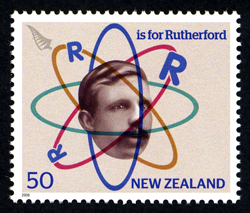|
|
Vol.
32 No. 1
January-February 2010
R is for Rutherford
He may well be the best-known scientist born and raised in New Zealand and the most famous physicist to receive the Nobel Prize in Chemistry (1908). Ernest Rutherford was born in 1871 in a rural community near Nelson, on the South Island of New Zealand. He received his early education at local schools and then attended Canterbury College (1890–1895), where he obtained B.A., M.A., and M.Sc. degrees in math and physics and did research on the magnetic properties or iron exposed to high-frequency oscillations. After a three-year stint at Trinity College in Cambridge, England, he accepted a position as a professor of physics at McGill University in Montreal, where he conducted most of the work that led to the Nobel Prize “for his investigations into the disintegration of the elements and the chemistry of radioactive substances.” He subsequently investigated the nature of alpha rays and established the nuclear structure of the atom while at the University of Manchester (1907–1919). From there, he succeeded J.J. Thomson as head of the famous Cavendish Laboratory at Cambridge, where he remained until his death in 1937. A talented experimentalist and gifted mentor, he is regarded as one of the most important scientists of the 20th century. Element 104 (rutherfordium, Rf) is named after him.
 |
The stamp illustrated herein is part of an eclectic set of 26 stamps (A through Z . . ) issued by New Zealand Post on 6 August 2008 to celebrate the achievements and cultural heritage of New Zealanders. Thus, G is for Goodnight Kiwi, a beloved cartoon character that used to signal the end of nightly broadcasts on New Zealand television, and K is for Kia Ora, a traditional Maori greeting that literally means “be well” but is indistinctly used to say hello or goodbye. Rutherford, coincidentally bestowed with the honor of representing the letter R stamp on the centennial of his Nobel Prize, is the only scientist portrayed on the set. He may have spent most of his professional career in Canada and the UK, but there’s little doubt that most people in New Zealand consider him a source of national pride, a cultural icon, and a symbol of kiwi ingenuity.
Written by Daniel Rabinovich <[email protected]>.
Page
last modified 22 January 2010.
Copyright © 2003-2009 International Union of Pure and Applied Chemistry.
Questions regarding the website, please contact [email protected] |